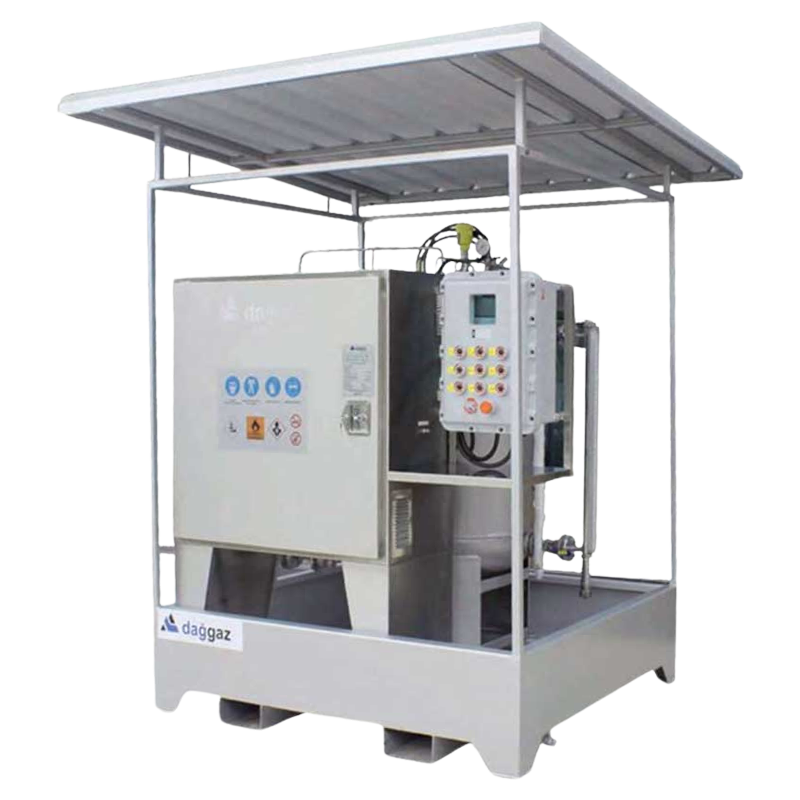Bio Gas Odorizing System
Bio Gas
Odorization is a crucial safety measure in biogas systems, especially when the biogas is upgraded to biomethane (CBG) for pipeline injection or vehicle fuel use. Raw biogas is naturally odorless, making leaks difficult to detect. Adding a distinct, recognizable odorant allows for rapid identification of leaks, preventing potential hazards like explosions or asphyxiation. The odorizer unit is the heart of this process, precisely injecting the odorant into the biogas stream
WHY WE ARE DIFFERENT?
PERFECT SOLUTIONS FOR CUSTOMER NEEDS RMS A, RMS B, RMS C APPLICATIONS, ATEX CERTIFICATE SOLAR POWER FUNCTION, DIFFERENT TYPES OF ODORANTS, WIDE RANGE OF FLOW RATES, RURAL OR RESIDENTIAL AREAS Dağgaz Odorizing is, a company specialized for gas odorization and related fields, We sell odorants, provide logistics and technical services for odorants, manufacture odorant injection systems, supply odor measurement solutions, supply odor neutralizing chemicals and equipments. Daggaz is a unique player in the market as a reliable, experienced partner.
Description
- By designing customized systems for our customers' needs, we provide perfect solutions for all requirements
- Solar powered systems
- Compatibility with different chemical species
- Compatibility with wide flow range
- Easy operation and easy maintenance
- Simplified pump design
- Pump options to API 675 standards.
- Ability to integrate another pump into the system if requested
- Automatic and manual operation options according to flow information or default (fixed) flow
- Instant feedback and warnings that detect system errors and failures
- Optional D Class control panel
- ATEX, EAC, CE approval|
- Electric pump design as per API 675
- Automatic control system
- immediate feedback and alarms during system errors and faults.
- Separate ATEX certificate for whole pump cabinet
- CE marked NG Odorizing System
- d class exproof controller cabinet or non exproof controller cabinet
- Production according to Shell DEP standards
IN-HOUSE PRODUCTS
Daggaz NG Odorizing Systems Component Origin List
|
1. Fittings and Valves: |
HAM-LET or /and PARKER or/and ASTEC http://www.ham-let.com http://www.parker.com http://www.astecflow.com |
|
2. Regulator: |
Fisher, Emerson USA / Taylor USA http://www2.emersonprocess.com https://taylorvalve.com/ |
|
3. Pipes: |
Borsen, Turkey (Ham-Let Distributor) http://www.borsenboru.com/en/ |
|
4. Solenoid Valves: |
Asco (Emerson) www.asco-process-scope.com II 2 G/D Ex mb II TS. T3 / Ex mD 21, IP67 |
|
5. Calibration Column |
Daggaz, Turkey www.daggaz.com |
|
6. Pump Cabinet |
Daggaz, Turkey www.daggaz.com |
|
7. Pneumatic Pumps |
Daggaz, Turkey www.daggaz.com |
|
8. PC- HMI |
Siemens, Germany www.siemens.com |
|
9. Exproof Controller Cabinet |
Bireks, Turkey or Dunya, Turkey or Asilsan, Turkey www.euroex.com or www.dunyaex.com |
|
10. Verometer (with ex-proof level transmitter from Dinel, Czech Republic) |
Daggaz, Turkey www.daggaz.com |
TECHNICAL DATA
| System Type | Tank Size, Max. [I] | Gas Flow, Max. [Nm3/h] | Gas Pressure, Max. [bar] with pump | Voltage [V] | Ex Zone 1 | Control System | Container | ||||
| - | - | - |
|
- | - | - | - |
APPLICATION-
1. On-site Biogas Utilization (e.g., Industrial Boilers, CHP):
Application: Even when biogas is used on-site, odorization can be beneficial, especially in larger facilities. It allows personnel to quickly detect leaks in the biogas piping system within the plant, minimizing risks to workers and preventing potential explosions.
2. Biogas Upgrading to CBG for Pipeline Injection:
Application: This is where odorization becomes absolutely critical. CBG injected into natural gas pipelines must be odorized to meet safety regulations. This ensures that if the CBG leaks from the pipeline, it can be detected just like natural gas, which is already odorized. These systems precisely control the odorant injection rate based on the CBG flow, ensuring consistent odorization even with variations in production. Redundancy (backup odorizer units) is often built into these systems for reliability.
3. CBG as Vehicle Fuel:
Application: CBG used as a vehicle fuel (either in dedicated CBG vehicles or blended with CNG) also needs to be odorized. This is vital for detecting leaks in vehicle fuel systems and at CBG dispensing stations. The odorization level must be carefully controlled to ensure safety without creating an overwhelming smell at the refueling point.
4. Anaerobic Digestion (AD) Plants (Pre-CBG):
Application: While not always required, some AD plants (before the biogas is upgraded to CBG) might choose to implement odorization. This can be particularly useful in large AD facilities or those located near residential areas. It allows for early detection of biogas leaks within the AD plant itself, improving safety and potentially mitigating odor complaints from neighbors.
5. Research and Pilot-Scale Biogas Systems:
Application: Even small-scale biogas systems used for research or pilot projects can benefit from odorization. It's a good safety practice, even when dealing with smaller volumes of biogas. Simple, low-cost odorization methods can be used in these cases, as the gas volumes are typically relatively small

